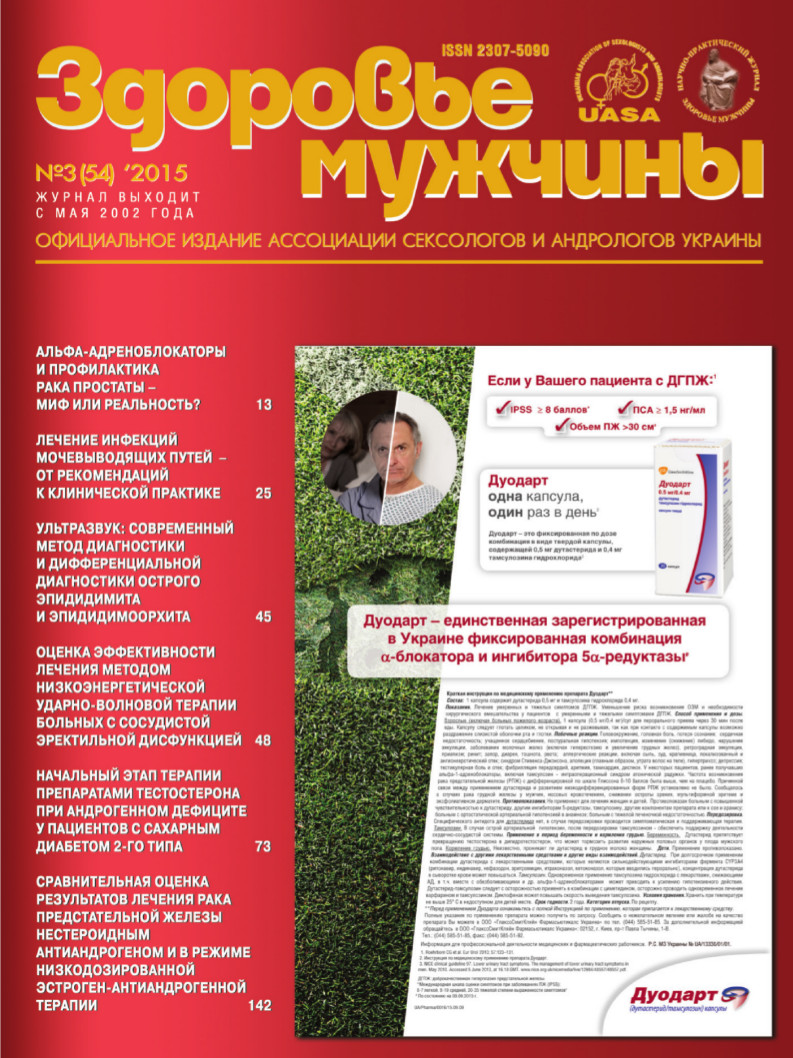Evaluation of potential preventive drug Canephron® N in treatment of recurrent cystitis in women of reproductive age
##plugins.themes.bootstrap3.article.main##
Abstract
In the article the data open, mono center, prospective study, conducted at the Institute of Urology control NAMS Ukraine which participated 60 patients with recurrent cystitis in exacerbation caused by Escherichia coli, which were divided into groups and comparing the basic. The main group besides antibacterial drug took Phitopreparation Canephron® N for 3 months after basic treatment. The results show that taking Canephron® N reduces the number of positive bacteriological urine 7 days after receiving a / b, and 20% reduces the number of recurrences after 12 months of follow – 16,67% and 36,67% p <0,05 in and control group, respectively, without causing any adverse reactions.
##plugins.themes.bootstrap3.article.details##

This work is licensed under a Creative Commons Attribution 4.0 International License.
Authors retain the copyright and grant the journal the first publication of original scientific articles under the Creative Commons Attribution 4.0 International License, which allows others to distribute work with acknowledgment of authorship and first publication in this journal.
References
Иванов Д.Д. Кушниренко С.В. Острый цистит у детей. Лечебный и профилактический потенциал фитотерапии // Здоров’я України, 3, 2014.
Иванов Д.Д., Назаренко В.И., Кушниренко С.В. и соавт. Фитотерапия метаболического синдрома и сахарного диабета 2 типа: возможности фитониринга // Здоров’я Украiни. – 2005. – No 17. – С. 46–47.
Урология. Национальное руководство / под ред. Н.А. Лопаткина. – М.: ГЭОТАР-Медиа, 2009. – 1024 с.
Abdul-Ghani AS, El-Lati SG, Sacaan A, et al. Anticonvulsant effects of some Arab medicinal plants. Int J Crude Drug Res 1987;25:39–43.
Barbosa-Cesnik C. Cranberry juice fail stop revent recurrent urinary tract infection: results from a randomised placebo-controlled trial / C. Barbosa-Cesnik, MB. Brown, M. Buxton, et al. // ClinInfectDis 2011 Jan;52 (1):23–30.
Bauer HW. Prevention of recurrent urinary tract infections with immuno-active E. сoli fractions: a meta-analysis of five placebo-controlled double-blind studies / HW. Bauer, VW. Rahlfs, PA. Lauener, etal. // Int J AntimicrobAgents 2002 Jun;19 (6):451–6.
Boscia JA. A symptomatic bacteriuriain theelderly. / JA. Boscia, D. Kaye // Infect. Dis. Clin. North Am. 1987;1:893–905.
European Scientific Cooperative on Phytotherapy. Centaurii herba (Centaury herb). In: ESCOP Monographs. 2nd ed. Stuttgart, Germany, and New York: Thieme-Verlag, 2003:70–73.
European Scientific Cooperative on Phytotherapy. Rosmarini folium (Rosemary leaves). In: ESCOP Monographs. 2nd ed. Stuttgart, Germany, and New York: Thieme-Verlag; 2003: 429–436.
Gracza L, Koch H, Loffler E. Isolierung von Rosmarinsäure aus Symphytum officinale und ihre anti-inflammatorische Wirksamkeit in einem In-vitro-Modell. Arch Pharm 1985;318:1090–1095.
Greenberg А. History of Genitourinary Disease, 1990.
Haloui M, Louedec L, Michel B, Lyoussi B. Experimental diuretic effects of Rosmarinus officinalis and Centaurium erythraea. J Ethnopharmacol 2000;71:465–472.
Johnson JR. Virulence factors in urinary tract infection. / JR. Johnson // ClinMicrobiolRev 1991;4:80–128.
Kontiokari T. Randomised trial of cranberry-lingonberry juice and Lactobacillus GG drink for the prevention of urinary tract infections in women/ T. Kontiokari, K. Sundqvist, M. Nuutinen, et al. // BMJ 2001Jun;322(7302):1571.
Kumarasamy Y, Nahar L, Cox PJ, et al. Bioactivity of secoiridoid glycosides from Centaurium erythraea. Phytomedicine 2003;10:344–347.
Kumarasamy Y, Nahar L, Sarker SD. Bioactivity of gentiopicroside from the aerial parts of Centaurium erythraea. Fitoterapia 2003;74:151–154.
Naber KG. Immunoactive prophylaxis of recurrent urinary tract infections:a meta-analysis. / KG. Naber, YH. Cho, T. Matsumoto, etal. // Int J AntimicrobAgents 2009 Feb; 33 (2): 111–9.
Naboka I.L. Bacterial mixed infection in women with chronic recurrent cystitis/ I.L. Naboka, M.I. Kogan, L.I. Vasil’eva, I.A. Gudima, E.A. Miroshnichenko, and K.S. Ibishev// Zhurnal Mikrobiologii, Epidemiologii, i Immunobiologii, no. 1, pp. 8–12, 2011.
Nickel J.C. Prevalence an dimpact of bacteriuria and / or urinary tract infection in interstitial cystitis / painful bladder syndrome / J.C. Nickel, D.A. Shoskes, and K. Irvine-Bird, // Urology, vol. 76, no. 4, pp. 799–803, 2010.
Rampart M, Beetjens JR, Bult H, et al. Complementdependent stimulation of prostacyclin biosynthesis; inhibition by rosmarinic acid. Biochem Pharmacol 1986;35: 1397–1400.
Raz R. A controlledtrial of intravaginal estriolin postmenopausal women with recurrent urinary tract infections./ R. Raz, WE. Stamm: // N Engl J Med 1993;329:753–756.
Stanfordand E. Thereis a low incidence of recurrent bacteriuriain painful bladder syndrome /interstitial cystitis patients followed longitudinally / E. Stanfordand, C. McMurphy // International Urogyne cology Journal and PelvicFloorDysfunction, vol. 18, no. 5, pp. 551–554, 2007.
Stothers L. A randomized trial to evaluate effective ness and cost effective ness of naturopathic cranberry products as prophylaxis against urinary trac tinfection in women / L. Stothers // Can J Urol 2002 Jun; 9(3):1558–62.
Valentao P, Fernandes E, Carvalho F, et al. Hydroxyl radical and hypochlorous acid scavenging activity of small centaury (Centaurium erythraea) infusion. A comparative study with green tea (Camellia sinensis). Phytomedicine 2003;10:517–522).
Yamahara J, Konoshima I, Sawada I, Fujimura H. Biologically active principles of crude drugs: pharmacological actions of Swertia japonica extracts, swertiamarine and gentianine. Yakugaku Zasshi 1978;98:1446–1451.
Yarnell E. Botanical medicines or the urinary tract. World J Urol 2002;20:285–293.





